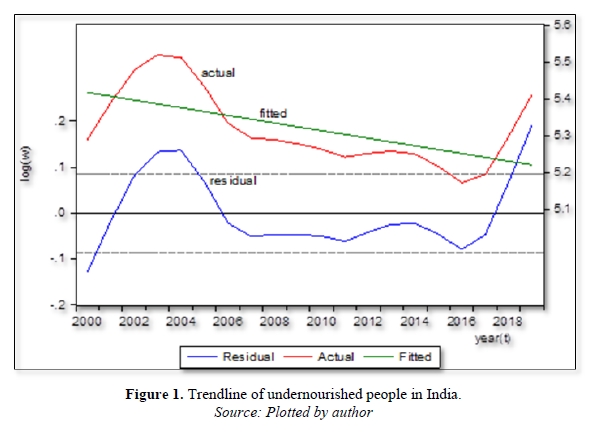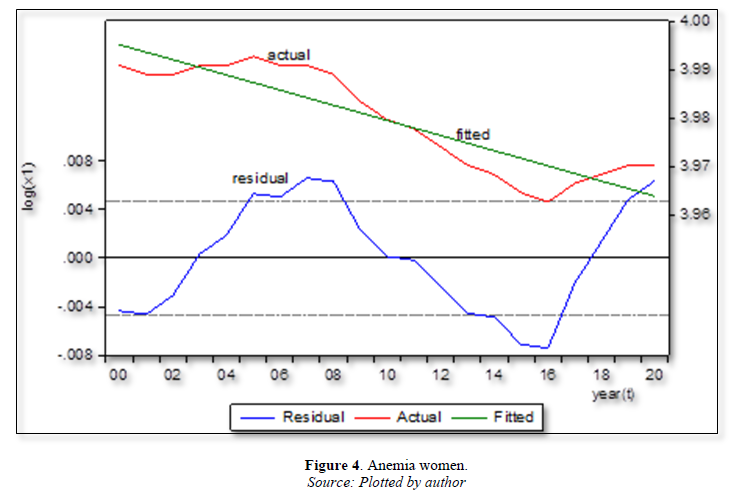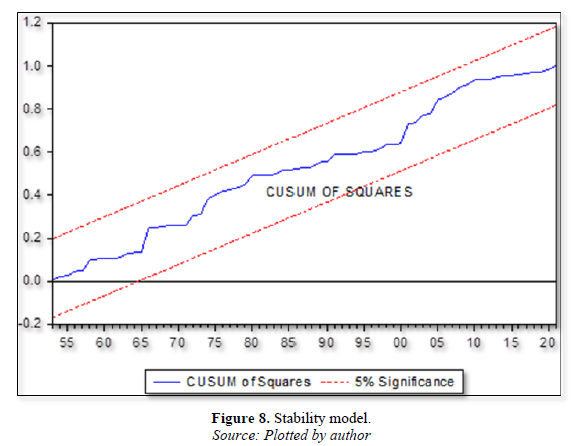2669
Views & Citations1669
Likes & Shares
JEL codes: C13, C22, D63, I30, N3, N5, P46
NITI Aayog, in partnership with the UN in India, has been promoting the localization of SDGs at the policy level through the GoI-UN Sustainable Development Framework, and NITI Aayog-UNDP Partnership Framework for Inclusive and Equitable Growth where ending poverty, hunger and inequality are one of SDG of India emphasizing the SDG India index 2020-2021. NITI Aayog’s mandate as the nodal agency for SDGs and the UN’s role as the leading advocacy group for SDGs in the country, make these parties natural partners in an institutionalized context.
But, India is off track on three of the global maternal, infant, and young children nutrition (MIYCN) targets to address stunting, wasting, anemia, low birth weight, breastfeeding, and childhood obesity [6].
Uphaus [7] ensured that increasing agricultural productivity in developing countries is necessary to reduce hunger and poverty, especially in the face of rapidly rising food prices. The success of broad-based economic growth and the Millennium Development Goals depend on Agricultural and rural development where Asia and Sub-Saharan Africa showed success story introducing these policy goals to reduce hunger and poverty. Presently, the rich countries follow the disinvestment in agriculture and protectionist trade and agriculture policies but new investments would be more effective if these policies were reformed.
The increase in productivity which was experienced from the degree of tradability of the food and non-food, determines the reduction of poverty from growth in that sector, affects the price decline from where the producers and consumers gain. Taking the samples of 300000 households from 31 countries and used computable general equilibrium model simulation and found that agriculture’s advantage holds, irrespective of whether food is considered tradable or not. Agricultural growth appears a priority for poverty reduction in landlocked and coastal economies alike [8].
This article endeavors to explain general concepts of poverty, hunger and inequality and discuss about the role of agriculture in explaining Indian poverty, hunger and inequality under different indicators.
METHODOLOGY AND SOURCES OF DATA
The data on India’s undernourished people during 2000-02-2019-21, average protein supply in gm/capita/day in 3-year average during 2000-02-2019-21, undernourished people (in million) at 3 year average during 2000-02-2019-21, malnutrition child under 5 (%) during 2000-2020, per capita daily food availability in gram from 1951 to 2021 the data on prevalence of anemia women of reproductive age (15-49yrs), per cent of child malnutrition under 5, and per capita food supply, cal/cap/day from 2000 to 2020, have been collected from FAO [4] and data on per capita availability of some essential commodities like edible oil, vanaspati, sugar, cloth, tea and coffee during 1960-61 to 2015-16 were obtained from Ministry of finance, Economic survey,17-18 respectively.
The linear trendline of regression was done by using semi-log regression model, xi=a+bt+ui where xi=variable, a and b are constants, t=time and ui=random error. The nonlinear semi-log regression model for trendline is given as follows: yi=a+bt+ct2+dt3+et4+ui, where yi=variable, a,b,c,d,e are constants, t=time, ui=random error.
POVERTY
Sen [9] wrote that the poverty is the subject matter of deprivation which changes from the absolute condition to relative condition. Generally, poverty is divided into absolute poverty and relative poverty. Poverty is relative because differentiating the poor and non-poor is essentially non-formal. There are many concepts to measure poverty, such as, [i] head count ratio, [ii] poverty gap ratio, [iii] normalized poverty gap, [iv] average poverty gap, [v] poverty intensity ratio, [vi] generalized deficit ratio, [vii] poverty burden ratio, [viii] poverty removal ratio, [ix] geometric gap ratio, [x] P index of poverty, [xi] substitute index of poverty, [xii] M index of poverty, [xiii] human poverty index and so on.
There is inverse relation between poverty and economic growth. Kakwani [10] studied that a one percent increase in growth in agriculture reduces the incidence of poverty by a little more than one percent. The corresponding figures for industry and services are substantially lower at amount a quarter to a third of one percent. Kakwani and Pernia [11] also verified that poverty reduction depends on the rate of economic growth as well as on the changes in income distribution. In a broader sense, there are causal link among international trade, growth, poverty and sustainable development. UNDP set sustainable development goals for zero poverty.
Whether a poverty line should be drawn in terms of an income level or in terms of some failure of basic functioning including nutritional performance. It is argued that deprivation is best seen in terms of the failure of certain basic functioning rather than in terms of variable such as income or calorie intake which should be seen as means and not as ends in themselves. Whether the expression poverty should be used to refer to deprivation in the general sense, or to the low level or commodity command contributing to that deprivation, is of secondary importance. The capability approach focuses on [i] given the interpersonal and intrapersonal variation in the relation between nutritional intakes and human functioning ,the distinction between income and commodities on one hand and functioning and capabilities on the other, can be very substantial indeed.[ii] the distinction between commodity command and functioning ability can be particularly important when dealing with groups that have systematic disadvantages for biological or social reasons, [iii] the capability approach draws attention to the general need to consider inputs other than food as determinants of nutritional functioning and capability. Nutritional achievements may be strongly influenced by the provision of and command over certain crucial non-food inputs such as health care, basic education, clean drinking water or sanitary facilities [12].
Poverty and inequality go hand in hand and there is high degree of association between them. Following Andre Macfarlane [13] was forced to comment that in essence, the modern situation is the civilization which proclaims equality but practices inequality. The great paradox of the modern world is that everywhere men attach themselves in the principle of equality and everywhere they encounter the presence of inequality. The more strongly they attach themselves to the principles of equality the more oppressive the reality becomes.
Sen [14] has explored that the theory of inequality evaluation has close links with that of assessment of poverty, and the choice of space becomes a central concern in identifying the poor and in aggregating the information about the states of those identified. If poverty is seen as the deprivation of some minimum fulfillment of elementary capabilities, it becomes easier to understand why poverty has both an absolute and a relative aspect. These considerations are important in dealing with poverty in any country. If a claim that inequality in some significant space is right (or good, or acceptable, dissenters), the argument takes the form of showing this inequality to be a consequence of equality in some other -more centrally important-space. Given the broad agreement on the need to have equality in the base and also the connection of that broad agreement with this deep need for impartiality between individual.
Needless to say, Sen [15] emphasized that the concept of equity and justice have changed remarkably over history and the concept of inequality has gone through radical transformation. Therefore, it is consistent that a higher degree of inequality corresponds to a lower level of social welfare for a given total of income. His conclusion is that the mixture of descriptive and normative considerations in the concept of inequality and inherent incompleteness of that concept, inequality evaluation has been seen in terms of non-compulsive, evaluative judgments expressed as quasi-orderings.
Moreover, it is understood from Sen [9] that famines imply starvation, but not vice versa, and starvation implies poverty, but not vice versa. Poverty exists even when no serious starvation occurs. On the other hand, starvation does imply poverty since the absolute dispossession characterizes starvation but the regular starvation has to be distinguished from violent outbursts of famines.
HUNGER
According to Wikipedia, “Hunger is defined as a condition in which a person does not have the physical or financial capability to eat sufficient food to meet the basic nutritional needs for a sustained period.” It was found from the world report of Food Security and Nutrition that the number of people suffering from chronic hunger began to rise gradually between 2014 and 2019. In 2020, there is a significant increase resulting in 768 million people suffering from malnutrition. FAO [4] explains that “Hunger is an uncomfortable or painful physical sensation caused by insufficient consumption of dietary energy. It becomes chronic when the person does not consume a sufficient amount of calories (dietary energy) on a regular basis to lead a normal active and healthy life. Undernourishment is an indicator to estimate extent of hunger. When someone is severely food insecure, they have run out of food and gone a day or more without eating. In other words, they have most likely experienced hunger. Children facing hunger food insecurity and under nutrition today may have a higher risk of underweight, obesity and chronic diseases like diabetes later in life”. Moreover, FAO [4] emphasized that “Hunger or chronic undernourishment exists when calorie intake is a below the minimum dietary energy requirement. All hungry people suffer from malnutrition, but people who are malnourished may not be hungry. Food insecurity occurs when people are at risk, or worried about not being able to meet their preferences for food, including in terms of raw calories and nutritional value. Very low food supply can be described as food insecure with hunger”.
In ‘Hunger in the contemporary world’, Sen [16] explains that food production is indeed an important component of solving the problem of hunger in the modern world. But much else also needs to done, including among other things; [i] enhancement of general economic growth, [ii] expansion of employment and decent rewards for work, [iii] diversification of production, [iv] enhancement of medical and health care, [v] arrangement of special access to food on the part of vulnerable people (including deprived mothers and small children), [vi] strengthening of democracy and the news media, [viii] reduction of gender-based inequalities. Sen reiterates that “Hunger is primarily a problem of general poverty and deprivation of food entitlement and adequate health and social care. Prevention of severe and uneven inflation is, thus, an important part of achieving food security. Distributional disparities can have a major impact on the wellbeing and productivity of the neglected members. A significant loss of human capital can be among the impacts of early undernourishment, and this interdependence adds to the direct consequences of nutritional deficiency or health and welfare. Thus, hunger involves much more than food and the solution of hunger in the contemporary world also calls for taking note of many different interconnections”.
In Hunger and Public Action, Dreze and Sen [12] examined the problem of hunger in the modern world and the role of public opinion might play in combating it, and provided a coherent perspective on the complex nutritional economic, social and political issues involved in the analysis of hunger. They explored famine prevention through a series of case studies in Africa and elsewhere and discussed the problem of chronic undernourishment.
The dictionary meaning of Hunger is “discomfort or painful sensation caused by want of food”. Ending hunger is to conquer food deprivation in general which include undernourishment, debilitation, fatigue, morbidity and mortality. To combat chronic hunger actions needed to change institutional building, legal reform, asset redistribution or provisioning in kind. To handle chronic hunger is an endemic feature which was experienced in China during 1958-61. The problem of chronic under nutrition is closely related to deficiency of food intake and deprivation of education, healthcare, basic facilities and social environment. Inequalities of distribution of food, general lack of affluence, slump famine and boom famine, comparative economic power to command food in the market, institutional wage structure, agricultural technology and environmental degradation are general phenomenon of hunger as indicated by Dreze and Sen [12].
Sen [17] in a lecture in Forum of Free Enterprises said that the problem of hunger can be broadly classified into two types, [i] famine, [ii] endemic deprivation. Famine and chronic undernourishment have different through related causal backgrounds and strategic issues that arise in dealing with the respective problems can be quite different. He classified the theme under the following issues ,e.g., [i] Pessimism versus remedial action, [ii] Public action ,the economy and the society, [iii] Endemic undernourishment, health and education, [iv] markets and participatory growth , [v] public provisioning and mortality reduction, [vi] Famines as entitlement failure, [vii] Income creation and public intervention, [viii] food production, diversification and economic growth, [ix] social security, environment and peace, [x] public employment for famine prevention, [xi] cash wages, public action and private trade, [xii]economic reasoning and public experiences,[xiii] Political incentives, news media and democracy, [xiv] Ending hunger through integrated Public Action, [xv] Public action and the public.
Moreover, the World Bank study on Poverty and Hunger suggests that more than 500 million women, children and men are reported to suffer from chronic malnutrition or famine and each year some 40 million people die from hunger and hunger related diseases.
Agriculture, poverty and hunger
According to the study of ADB, Indian poverty ratio was measured as Rs 356.30/month/man in rural area and Rs 538.60/month/man in urban areas as per 2004-05,in which it was found that 56.4% people in rural area and 49.0% people in urban area were below the poverty line in 1973-74 which increased in rural area and decrease in urban area in 1977-78 which again was reduced to 45.7% in rural area and 40.8% in urban area in 1983 followed by downward trend till 2004-05 in which both rural and urban poverty increased to 28.3% and 25.7% respectively (Table 1). But it is really alarming that during 1973-74-2004-05, both the rural and urban Gini index have been showing upward trend which implies that inequality is rising.
From the study of RBI, it was found that poverty line was assumed Rs 446.68 per month per person in rural area and Rs 578.80 per month per person in urban area which indicated that 45% people in rural area and 25.50% people in urban area constituted below the poverty line in 2004-05 which decreased to 33.8% and 20.60% in both areas in 2009-10 where Rs 672.80per moth per person and Rs 859.60 per month per person were the poverty line in both areas respectively. In 2011-12, people in rural and urban areas were reduced to 25.70% and 13.70% according to poverty line Rs 816.0per month per son and Rs 1000 per man per person in both rural and urban areas respectively (Table 2).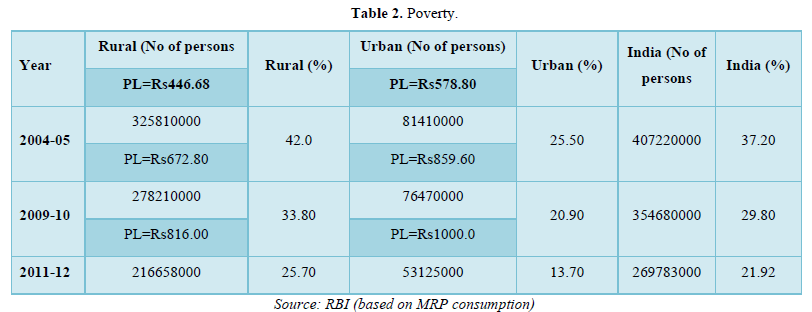
Moreover, World Bank studied Indian poverty assuming poverty line as US$ 2.15 per man per day at PPP in 2019 and found that 11.6% people in rural area and 6.3% people in urban area have been lying below the poverty line.
On the other hand, Global Hunger Index-2022 indicated that India’s hunger index is marginally increased to 29.1 in 2022 from 2014 which is serious where India has ranked 107 out of 121 countries in the world. In the Table 3 India’s Global Hunger Index score since 2000 have been observed.
Since 2000, India has made substantial progress but there are still areas of concern particularly regarding malnutrition. India improved by 3.2%. In case of India, GHI, 2022 was calculated on the basis of malnourishment, child stunting and wasting and under five mortality rates. Global Hunger Index asserted that the score below 9.9 is low,10.0-19.9 indicates moderate,20.0-34.9 is assumed as serious,35.0-49.9 shows alarming and greater than 50.0 is extremely alarming.
Kumaran [18] studied the Indian scenario of hunger during 1983-2004-05 in which he took the measure of no full square meal a day and found that 18.3% people in rural area and 6.33% people in urban area have been suffering from hunger which were reduced to 2.4% in rural area and 0.5% in urban area in 2004-05 belonged to hunger (Table 4).

FAO [4] examined the position of India’s undernourished people during 2000-02-2019-21 where the undernourished people had been declining at the rate of 1.03% per year significantly. The estimated trendline is given below.
Log(w) = 5.936-0.01038t
(29.77)* (-3.11)*
R2 = 0.35, F = 9.698, DW = 0.529, w = undernourished people (in million) in 3 year average. * = significant at 5% level. N = 20
The estimated trendline is shown in (Figure 1) below.

In India, the average dietary energy supply adequacy (%) in 3-year average during 2000-02-2019-21 had been increasing at the rate of 0.59% per year significantly whose estimation is given below.
Log(y) = 4.308+0.00594t
(141.21)*(11.64)*
R2 = 0.88, F = 135.49, DW = 0.699, y = average dietary energy supply adequacy (%) in 3 year average, * = significant, n = 20, t = year
The estimated trendline is plotted below where the trendline is upward in Figure 2.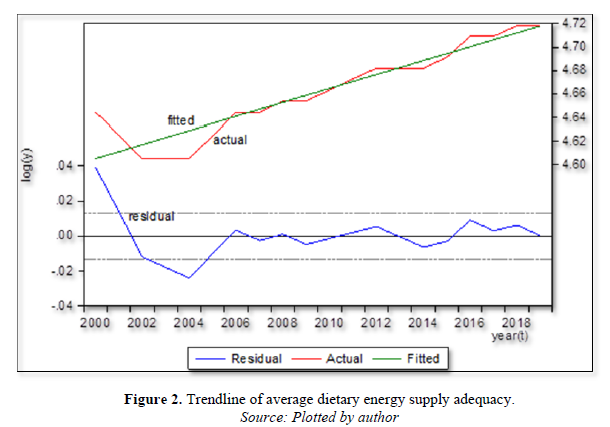
In India average protein supply in gm/capita/day in 3-year average during 2000-02-2019-21 had been growing at the rate of 1.08% per year significantly in which its estimated trendline is shown below.
Log(z) = 3.4303+0.01082t
(99.57)*(18.77)*
R2 = 0.95, F = 352.56, DW = 0.56, Z = average protein supply in gm/capita/day in 3 year average, t = year, n = 20, * = significant.
The trendline of the average protein supply is plotted below in Figure 3.

In Table 5, number of undernourished people (in million) at 3 year average during 2000-02-2019-21 in India have been given classifying average dietary energy supply adequacy (%),3-year average, average protein supply gm/cap/day at 3-year average and the millions of people respectively.
In India, prevalence of anemia women of reproductive age (15-49) had been declining at the rate 0.156% per year significantly during 2000-2020 which is estimated below.
Log(x1) = 4.073-0.00156t
(397.52)*(-9.205)*
R2 = 0.816, F = 84.736, DW = 0.28, x1 = prevalence of anemia women of reproductive age (15-49), t = year,* = significant at 5% level, n = 21
In Figure 4 the trendline is shown which is declining downward.
Indian malnutrition child under 5 (%) has been stepping down at the rate of 2.42% per year significantly which is rosy prospect and its estimation is given below.
Log(x2) = 5.195-0.02425t
(54.02)*(-15.206)*
R2 = 0.92, F = 231.23, DW = 0.099, n = 21, x2 = % of child malnutrition under 5,* = significant, t = year,
Its trendline is plotted below (Figure 5).

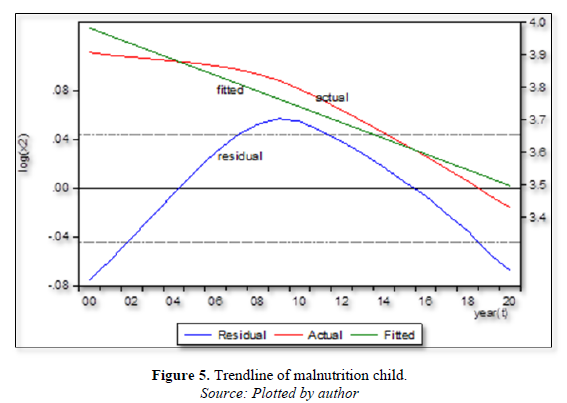
Per capita food availability in calorie/capita/day in India has been amazingly dwindling at the rate of 5.59% per year significantly during 2000-2020 in India which is given below.
Log(x3) = 6.643-0.0559t
(7.93)* (-4.03)*
R2 = 0.46, F = 16.24, DW = 0.93, x3= per capita food availability in cal/capita/day, t=year(t),n=21,*=significant at 5% level.
The estimated trendline is plotted in Figure 6 below.

In Table 6 the data on prevalence of anemia women of reproductive age (15-49 years), per cent of child malnutrition under 5, and per capita food supply, cal/cap/day from 2000 to 2020 have been arranged to verify the trends and nature for clarification of hunger and poverty in India.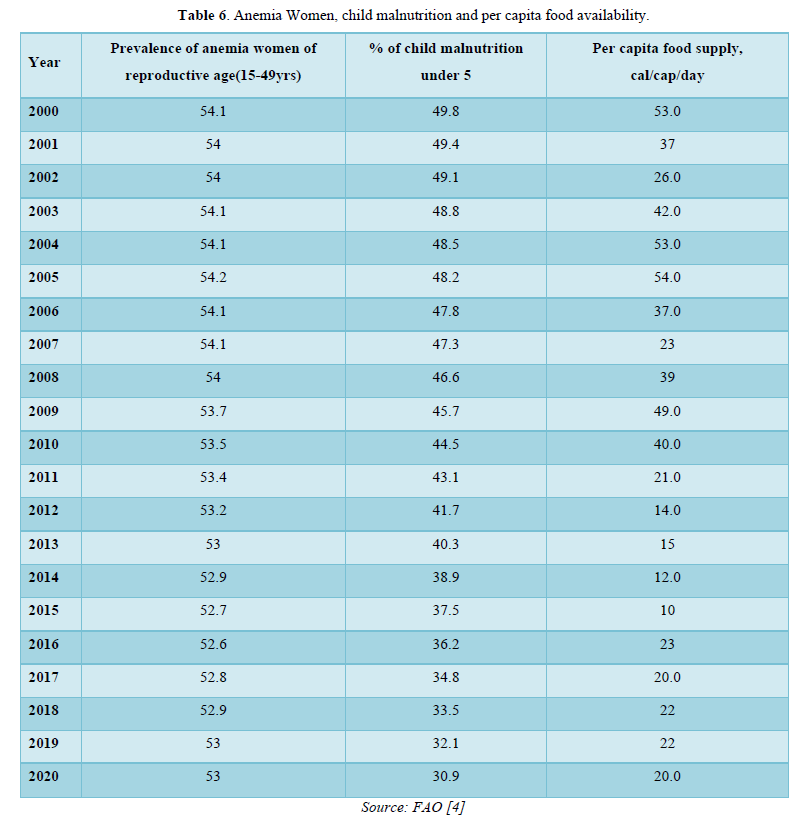
In India, per capita daily food availability in gram from 1951 to 2021 has been catapulting at the rate of 0.1525% per year significantly. Its estimated trendline is given below.
Log(x) = 6.0669+0.001525t
(458.67)* (4.77)*
R2 = 0.248, F = 22.80, n = 71, DW = 1.56, x = per capita daily food availability in gram, t=year, * = significant at 5% level.
In Figure 7 the estimated linear trendline of per capita daily food availability is depicted below where the trendline is upward sloping although its actual line is mostly irregular and volatile.

This linear trendline is seen as stable model since its CUSUM of squares line lie between ±5% level of significance which is plotted in Figure 8 below.
In the following Table 7 it is found that per capita availability of some essential commodities like edible oil, vanaspati, sugar, cloth, tea and coffee during 1960-61 to 2015-16 where all consuming articles have been increasing slowly except coffee which is downward followed by upward trend although the amounts of essential articles have not available as the citizen need in daily life.
According to Osmani [19], nutrition and poverty are too closely interrelated where being poor, hunger, inadequate health care, unhygienic living conditions; the stress and strain of precarious living tend to impair a person’s nutritional status. He opined that Payne [20] argued that there could be no state of nutrition in which all functions are simultaneously maximized assuming that the evolutionary process through which the human body has come to acquire its potential for functional abilities is suffering rather than optimizing in nature and there is always a trade-off between the functions so that improvement in one function typically entails the loss of another. The question is whether or not an ideal state exists which lead directly to controversies regarding the practical methods for assessing the magnitude of under nutrition. In this case the author assumed the concept of adaptation, i.e., facing nutritional constraints, human body adapts itself a number of ways to minimize the adverse consequence of that constraint.
There are two types of energy related nutritional deprivation e.g., calorie intake with some standard of requirement and compare anthropometric measurement of the body with some reference standard. Srinivasan [21] argued strongly for the abandonment of the fixed requirement model and for adoption of process view nutrition which operates in the short as well as in the long run. He supported the process view of nutrition and went on to review the appropriateness of standard policies for combating under nutrition as seen from the altered viewpoint. On the other hand, Gopalan [22] strongly argued against both short and long run and prescribed for variable requirement where interpersonal variation in requirement is widely recognized that genetic differences in metabolic efficiency can indeed lead to different levels of energy requirement for individual of the same type. Osmani [19] asserted that there are problems of choice of the reference standard when nutritional deprivation is measured in the anthropometric approach by comparing actual physical dimensions with standard set by the achievement of a chosen sample of healthy people. The question of interpersonal and intrapersonal variation also arises in this case. There is prevailing orthodoxy in favor of a fixed standard. Floud [23] clarified the statistical picture of changes of height in industrial world where he found that there has been a secular increase in height over the period as a whole but the progress was halted and found reversed during 19th century. Secondly, there is significant difference between countries in their time profiles of height change and thirdly, there are notable differences in the average height of different socioeconomic group within the same country. Fogel [24] made powerful use of this indicative role of height in throwing light on an aspect of the economic history of Europe where he suggested that it is the secular improvement in the nutritional experience of the population that explained the secular decline in mortality which showed the indicative role of height. However, Payne [20] suggested a novel measurement called body mass index for both children and adult members of a household to classify different households according to the binding constraint each of them faces.
POLICY ISSUES
The task of eradication of famine is a fairly straightforward since there many success stories in Asian and African countries while the problem of endemic under nutrition and deprivation is harder to deal with. Without government assistances, the public can do a great deal because the nature of government policy can depend very extensively on the public activism because government can handle it rapidly if there is firm political will and determination although there may be some technical issues concerning institutional structure, financing arrangement and relative costs having political leadership to achieve the objectives. The positive role of political pluralism can play in the eradication of hunger and deprivation where political pluralism relates to the importance of adversarial politics and social criticism in influencing state action in the direction of greater sensitivity to the well-being of the population. The dichotomy arises between the advantages of political commitment vis-à-vis those of political pluralism in which there are twin role of public between collaborative and adversarial where leadership may choose radical social change or may be hostile. The ideal combination is hard to realize [12].
Engle and Dustagheer [25] in dealing with hunger free India described that the causes of infant and child mortality of the developing world is the childhood malnutrition in which UNICEF suggests that care and feeding, in addition to food security, health care services and healthy environment are critical for survival, growth and development. Enhanced care giving can optimize the use of existing resources to promote good health and nutrition in women and children. Many factors influence nutrition other than food intake and care practices play a major role in influencing these other factors that affect good nutrition. Authors mentioned six types of care practices: [i] care for girls and women represents a pattern of behavior on the part of the family where adequate prenatal care and safe birthing, equal access to education are available, [ii] food preparation takes enormous amounts of caregiver time and efforts, [iii] hygiene practices have long been recognized as critical for child nutrition, [iv] home health practices include diagnosing illness in the home ,use of preventive health care and protection from pests and accidents, [v] good psychological care including warmth, verbal interaction and encouragement of learning causes improved cognitive development of children and is related to complementary feeding styles, and [vi] breastfeeding and complementary feeding practice is urgent. The other successful improved resources for care such as setting up community childcare facilities, improving community response to needs for child referral or strengthening women’s capacity to make decisions affecting community decisions.
Following SDG-1.2 on reducing by half the proportion of individuals of all ages living in poverty in all its dimensions, India set it target in 2030 using multi-dimensional poverty index and millennium development goals. India targeted the goals of [i] zero hunger, [ii] good health and well-being, [iii] quality education, [iv] affordable and clean energy, [v] clean water and sanitation, [vi] zero poverty. India aims to eradicate extreme poverty for all people everywhere, currently measured as people living on less than USD 1.25 a day by 2030 and to reduce at least by half the proportion of men, women and children of all ages living in poverty in all its dimensions according to national definitions. India planned to end hunger and endure safe, nutritious and sufficient food including infants and will end all forms of malnutrition by 2030.India will achieve gender equality and empower all women and girls ending all discrimination against women and girls. India will achieve and sustain progressively growth of the bottom 40% of population at a higher rate than the national average by 2030 [26].
CONCLUSION
The paper briefly explained the meaning and concept of poverty and hunger in context of the role of agriculture. The paper found that the Indian poverty has been reduced in both rural and urban areas but inequality has risen to some extents. The trendlines describe that undernourished people during 2000-02-2019-21, average protein supply in gm/capita/day in 3-year average during 2000-02-2019-21, undernourished people(in million) at 3 year average during 2000-02-2019-21 have increased but malnutrition child under 5 (%) during 2000-2020, per capita daily food availability in gram from 1951 to 2021have decreased, anemia women of reproductive age (15-49 years), per cent of child malnutrition under 5, and per capita food supply, calorie/capita/day from 2000 to 2020, have increased and some essential commodities like edible oil, vanaspati, sugar, cloth, tea except coffee during 1960-61 to 2015-16 have risen significantly. India’s target on SDG for 2030 in partnership with UNDP for zero poverty and hunger has been launched and it is hopeful to be successful.
ACKNOWLEDGEMENT
In preparing this article, no fund was sanctioned by any govt/NGOs or institutions. Author is fully responsible for all errors and omissions.
- Bhavani RV, Rampal P (2020) Harnessing Agriculture for Achieving the SDGs on Poverty and Zero Hunger. ORF Issue Brief 407. Available online at: https://www.orfonline.org/wp-content/uploads/2020/10/ORF_IssueBrief_407_Agri-SDGs.pdf
- Gassner A, Harris D, Dobie P (2019) Poverty eradication and food security through agriculture in Africa: Rethinking objectives and entry points. Outlook Agric 48(4): 309-315.
- Ahluwalia M (2005) Reducing poverty and hunger in India the role of agriculture. Available online at: https://www.researchgate.net/publication/23529847_Reducing_poverty_and_hunger_in_India_the_role_of_agriculture
- FAO (2017) Ending poverty and hunger by investing in agriculture and rural areas. Available online at: https://www.fao.org/3/i7556e/i7556e.pdf
- Banerjee D (2021) Poverty and deprivation in India Divergence between consumption and asset based estimates. Available online at: http://eprints.nias.res.in/2161/1/WP10-2021-Debosree-Banerjee.pdf
- Global Nutrition Report (2021) ENDORSEMENTS. Available online at: https://globalnutritionreport.org/documents/851/2021_Global_Nutrition_Report_aUfTRv0.pdf
- Uphaus C (2008) Ending hunger the role of agriculture Briefing Paper 3. Available online at: https://www.issuelab.org/resources/1124/1124.pdf
- Christiaensen L, Martin A (2018) Five new insights on how agriculture can help reduce poverty. World Bank Blogs. Available online at: https://blogs.worldbank.org/jobs/five-new-insights-how-agriculture-can-help-reduce-poverty
- Sen A (1981) Poverty and Famines an Essay on Entitlement and Deprivation
- Kakwani N (2001) A Note on Growth and Poverty Reduction. Asian Development Bank Manila.
- Kakwani N, Pernia EM (2000) What is ProPoor growth. Asian Dev Rev 18(1): 1-16.
- Dreze J, Sen A (1989). Hunger and Public Action. OUP.
- Macfarlane A (1999) Andre Beteille and Alexis de Tocqueville. In R. Guha & J. P. Parry (Eds.), Institutions & Inequalities Essays in Honor of Andre Beteille. New Delhi OUP.
- Sen A (1992) Inequality Reexamined
- Sen A (1973) On Economic Inequality. OUP.
- Sen A (1997) Hunger in the Contemporary World.
- Sen A (1998) Public Action to Remedy Hunger. Forum of Free Enterprises Mumbai
- Kumaran M (2008) Hunger and under nutrition in post liberalization rural India a review. JNU New Delhi.
- Osmani SR (1992) Nutrition and Poverty
- Payne P (1992) Assessing Under nutrition The Need for a Reconceptualization. In SR Osmani Nutrition and Poverty
- Srinivasan TN (1992) Undernutrition Concepts Measurements and Policy implications. In SR Osmani Nutrition and Poverty. OUP.
- Gopalan G (1992) Undernutrition Measurement and implications In SR Osmani Nutrition and Poverty pp: 17-48.
- Floud R (1992) Anthropometric Measures of Nutritional Status in Industrialized Societies: Europe and North America since 1750. In S.R. Osmani Nutrition and Poverty
- Fogel RW (1992) Second Thoughts on the European Escape from Hunger Famines Chronic Malnutrition and Mortality Rates In S.R. Osmani Nutrition and Poverty
- Engle PL, Dustagheer A (2001) Care for Development Contributions toward a Hunger Free India. In M.D. Asthana and Pedro Medrano. Towards Hunger Free India Agenda and Imperatives. New Delhi Manohar Publishers and Distributors.
- SDG (2021) India index and Dashboard 2021. Niti Aayog. Available online at: https://www.niti.gov.in/writereaddata/files/SDG_3.0_Final_04.03.2021_Web_Spreads.pdf
QUICK LINKS
- SUBMIT MANUSCRIPT
- RECOMMEND THE JOURNAL
-
SUBSCRIBE FOR ALERTS
RELATED JOURNALS
- Journal of Microbiology and Microbial Infections (ISSN: 2689-7660)
- Journal of Genomic Medicine and Pharmacogenomics (ISSN:2474-4670)
- Journal of Astronomy and Space Research
- Advances in Nanomedicine and Nanotechnology Research (ISSN: 2688-5476)
- Journal of Genetics and Cell Biology (ISSN:2639-3360)
- Food and Nutrition-Current Research (ISSN:2638-1095)
- Journal of Womens Health and Safety Research (ISSN:2577-1388)

